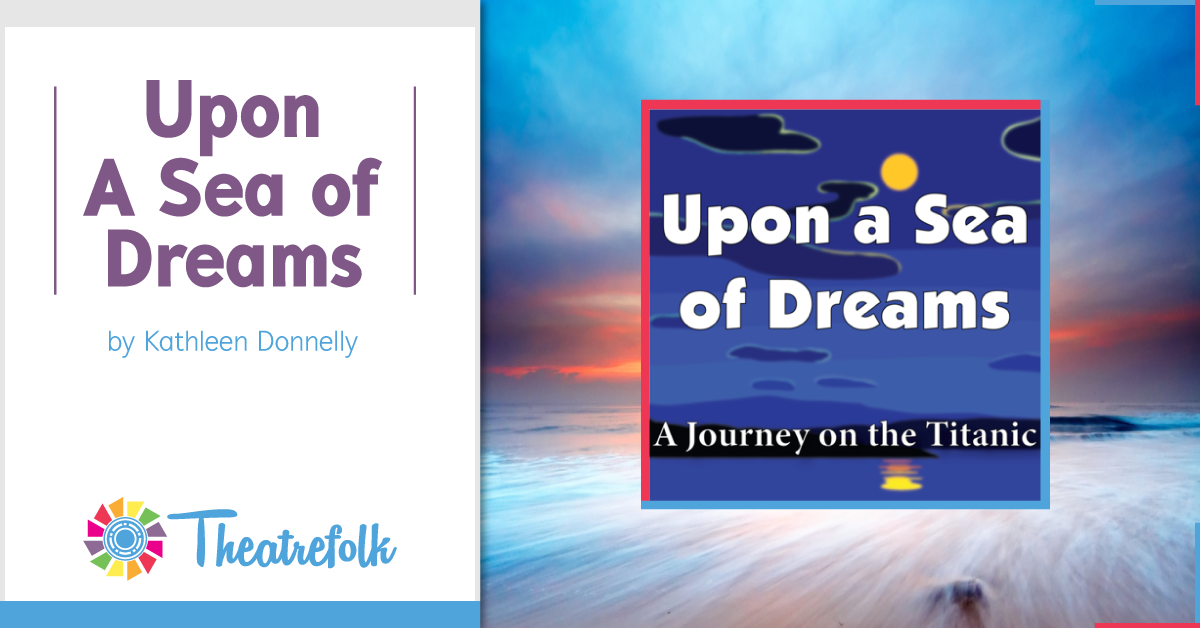Theatrefolk Featured Play – Upon a Sea of Dreams: A Journey on the Titanic by Kathleen Donnelly
Welcome to our Featured Play Spotlight. You know about the Titanic, but you won’t want to miss Upon A Sea of Dreams: A Journey on the Titanic – an amazing character-based drama by Kathleen Donnelly with a unique look at this infamous event.
It is the night of April 14, 1912. In a tiny third class cabin Emma struggles to quiet her infant brother and calm her younger sisters. The young girls think life on the Titanic is a game. They’re on their way to a new life in America after all.
But the playful air changes when the ship suddenly stops moving and sirens blast. The stewardess says they’re to stay in their cabins. The American boy says his deck is flooded and the ship is sinking. They have to get out now. Do the girls stay put or leave? And if they leave, how do they get past the locked gate?
Why did we publish this play?
If you don’t know the date, you know the event. On April 14, 1912 the Titanic struck an iceberg and sank into the frigid waters of the Atlantic. Upon a Sea of Dreams dramatizes this historical event by bringing to life a family in a tiny third class cabin. I love a cross-curricular play that doesn’t come across as a history lesson. The characters come first in Upon a Sea of Dreams. You connect to their story, their dreams and you want to know they’re going to make it past the locked gates and get out alive. Will they? You’ll have to read the play to find out!
Let’s hear from the author!
1. Why did you write this play?
I teach creative writing at a creative and performing arts school. I was working with a 6th grade playwriting class, and I wanted to demonstrate that you can write a play about anything, set anywhere. We’d done a brainstorming activity on the chalkboard, listing big moments in history, and somebody had written “The Titanic.” I randomly grabbed that topic and started to brainstorm how you could tailor a play set on a huge ship to fit a small theatre space. That night, I wrote an opening scene to share with the students as a model. We all enjoyed it so much, that I just continued writing the story. I don’t think I finished the script before that course ended, but I definitely had embraced the project by then.
I enjoyed every minute of researching the story, from the Titanic itself (I found Titanic’s cabin charts online and pinpointed a third-class cabin tucked away next to a stairwell that is, in my mind, where the play takes place), to exploring Irish culture to get a stronger hold on the family’s background. There were times after working on the script, that I felt like I’d spent the day out at sea on the North Atlantic — not a bad getaway without ever leaving Pittsburgh!
2. Describe the theme in one or two sentences.
I didn’t focus much on theme while writing this play, but now that the story’s down on paper, it seems to me that acts of sacrifice come up throughout the play that show how, ultimately, they are the greatest acts of love.
3. What’s the most important visual for you in this play?
Visually, if you’re talking staging and set, I think it’s creating that small, tight space of the cabin. Dramatically, it’s that moment of Emma all by herself in the cabin.
4. If you could give one piece of advice for those producing the play, what would it be?
While it would be very fun to recreate for the stage a (mostly) authentic rendering of a third-class cabin, I think that you could get away with a very minimalistic set for this show. Costuming and sound design could carry the weight of creating the atmosphere of the ship and the event.
And, do the accents. I think some of the dialogue could be a bit unwieldy without the rhythm of the Irish speech patterns.
5. Why is this play great for student performers?
Why is it great for student performers? Let me count the ways:
- I think the play offers challenging character work for young actors. These sisters know each other as intimately as sisters do — to realize these characters asks for fully present and honest acting that fills in all the moments between the lines, too. The role of the stewardess is a most challenging role for a young actor to inhabit the shoes and regrets of someone much older.
- The chance to do some strong vocal work through capturing the Irish dialects.
- The story of The Titanic seems to fascinate each new generation. It is a timeless story that students love, and yet…
- it’s a fantastic way to connect the arts and academics, through learning about this pivotal time in American history and the story of immigrants coming to America in the early 1900s.
- It continues to be a great model for students to see how a stage play can take you anywhere and to any event.



